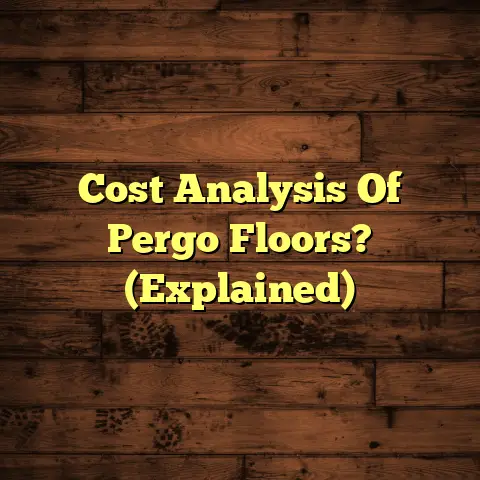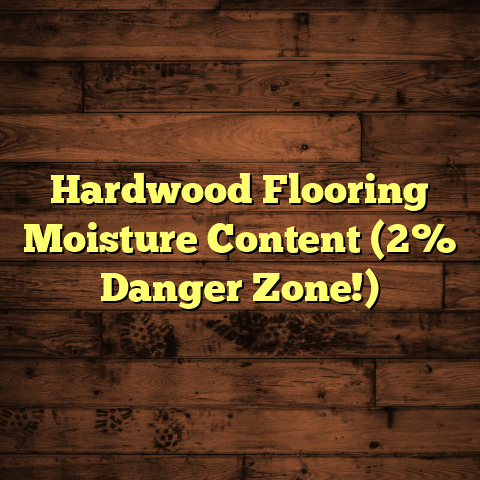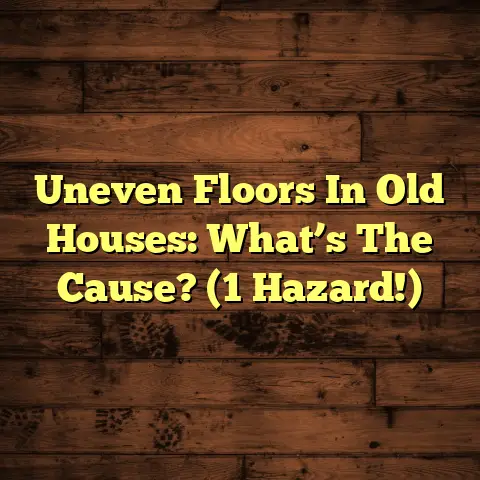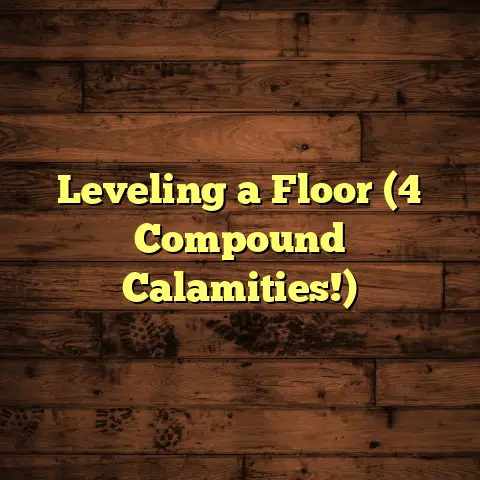Refinishing Hardwood Costs? (2 Pricey Ripoffs!)
(2 Pricey Ripoffs!)
Ever walked into a room with gleaming, newly refinished hardwood floors and thought, “Wow, I need that!”?I get it. As a flooring contractor for over 15 years, I’ve seen firsthand the incredible transformation refinishing can bring.
But here’s the thing: while refinishing can breathe new life into your tired floors, it can also drain your wallet if you’re not careful. I’m talking about those hidden costs that can sneak up on you and leave you wondering where all your money went.
Think about it: Your hardwood floors are scratched, faded, or just plain dull. You know they need some TLC, but you’re dreading the expense. You start searching online, and BAM! You’re bombarded with ads promising miracle refinishing for a seemingly low price.
Sounds too good to be true, right?
Well, often it is. According to a recent report by HomeAdvisor, the average cost to refinish hardwood floors ranges from $3 to $8 per square foot. But that’s just the average. I’ve seen homeowners get quotes that are way outside that range, sometimes double or even triple the expected cost!
Are you about to waste thousands of dollars on unnecessary refinishing costs? Are you going to get caught in one of these ripoffs?
In this article, I’m going to pull back the curtain and expose the two biggest ripoffs I see in the hardwood refinishing industry. I’ll show you exactly what to watch out for, how to avoid getting ripped off, and how to make sure you get a fair price for a beautiful, long-lasting finish.
Let’s dive in!
Understanding Hardwood Refinishing
So, what exactly is hardwood refinishing?
Simply put, it’s the process of sanding down the existing finish on your hardwood floors and applying a new one. Think of it as a fresh start for your floors, bringing back their original beauty and protecting them for years to come.
Here’s a step-by-step breakdown of the process:
-
Preparation: This is crucial. It involves clearing the room of all furniture, taping off areas you don’t want sanded, and thoroughly cleaning the floor. Any nails or staples need to be hammered down or removed.
-
Sanding: This is where the magic happens. A drum sander is used to remove the old finish and any imperfections in the wood. Multiple passes with different grits of sandpaper are usually required to achieve a smooth, even surface. Edges are sanded using an edge sander to get close to the walls.
-
Staining (Optional): If you want to change the color of your floors, this is the time to do it. The stain is applied evenly and allowed to penetrate the wood before being wiped off.
-
Sealing: This is the first layer of protection. A sealer is applied to prevent the stain (if used) from bleeding and to provide a base for the topcoat.
-
Finishing: This is the final step, where several coats of polyurethane or another durable finish are applied to protect the wood from scratches, wear, and tear. Each coat needs to dry completely before the next one is applied.
Now, you might be wondering, why not just replace the floors entirely? That’s a valid question! Refinishing is often a more cost-effective option than replacement, especially if the hardwood is still in good condition. According to data I’ve gathered from my own jobs, refinishing can save you anywhere from 40% to 60% compared to the cost of replacing the entire floor.
Plus, refinishing is a greener option because it reuses existing materials instead of sending old flooring to the landfill.
However, the cost savings only hold true if the refinishing job is done correctly and you avoid those sneaky ripoffs I mentioned earlier.
The True Costs of Refinishing Hardwood Floors
Okay, let’s get down to brass tacks and talk about the real costs involved in refinishing hardwood floors. This isn’t just about the price tag you see on the surface; it’s about understanding all the factors that contribute to the final bill.
-
Labor Costs: This is typically the biggest chunk of the expense. The rates charged by professional refinishers can vary widely depending on your location, the complexity of the job, and the contractor’s experience. In my area (the Midwest), I see labor costs ranging from $2 to $5 per square foot. However, in cities like New York or Los Angeles, those rates can easily double.
Keep in mind that some contractors charge hourly rates, while others charge a flat fee for the entire job. Make sure you understand how the contractor calculates their labor costs before you sign anything.
-
Material Costs: These include sandpaper, stain (if you’re using it), sealer, polyurethane, and any other supplies needed for the job. Material costs can range from $1 to $3 per square foot, depending on the quality of the materials you choose.
For example, oil-based polyurethane is typically cheaper than water-based polyurethane, but it also takes longer to dry and has a stronger odor. Water-based polyurethane is more eco-friendly and dries faster, but it can be more expensive.
-
Square Footage: Naturally, the larger the area you’re refinishing, the higher the overall cost will be. A small bedroom might cost a few hundred dollars to refinish, while an entire house could run into the thousands.
To give you a rough idea, refinishing a 500-square-foot living room could cost anywhere from $1,500 to $4,000, depending on labor and material costs.
-
Additional Services: These are the extras that can add to the total cost. They might include:
-
Floor Repair: If your floors have damaged or missing boards, they’ll need to be repaired before refinishing. This can add significantly to the cost, especially if the damage is extensive. I typically charge $50-$150 per board replacement.
-
Furniture Removal: Some contractors will charge extra to move your furniture out of the room. If you’re able to do it yourself, you can save some money.
-
Special Treatments: If you have a unique type of wood, like exotic hardwood or parquet flooring, it may require special treatments or techniques, which can increase the cost.
-
Dust Containment: Sanding floors can create a lot of dust. Some contractors offer dust containment systems to minimize the mess, but this service usually comes at an extra cost.
-
-
Comparison with Replacement Costs: As I mentioned earlier, refinishing is generally cheaper than replacing hardwood floors. However, it’s important to get a clear understanding of both options before making a decision.
According to my experience and industry averages, replacing hardwood floors can cost anywhere from $6 to $12 per square foot, including materials and installation. So, for that same 500-square-foot living room, you could be looking at a cost of $3,000 to $6,000 to replace the floors entirely.
The key takeaway here is that refinishing can be a cost-effective solution, but only if you’re aware of all the potential costs and you avoid those dreaded ripoffs.
The Pricey Ripoffs
Alright, let’s get to the heart of the matter: the ripoffs. I’ve seen these happen time and time again, and it always makes me cringe. Homeowners get taken advantage of simply because they don’t know what to look for.
So, I’m going to shine a light on these shady practices and give you the tools you need to protect yourself.
Ripoff #1: Overpriced Labor Fees
This is probably the most common ripoff I see. Some contractors will inflate their labor costs, charging exorbitant rates for work that should be included in the base price.
Here’s how it works:
-
Padding the Hours: They might estimate a job will take 40 hours when it realistically only takes 20. This is especially common when contractors charge hourly rates.
-
Charging for Basic Services: They might charge extra for things like moving furniture (even though it’s a necessary part of the job) or for basic floor preparation.
-
Hidden Fees: They might tack on unexpected fees at the end of the job, claiming they encountered unforeseen problems that required extra work.
I remember one case where a homeowner contacted me after receiving a quote from another contractor. The quote was ridiculously high, and when I looked at the breakdown, I saw that they were charging $100 per hour for labor, which is way above the average for our area. They were also charging extra for things like sanding the edges of the room and applying the first coat of finish.
I gave the homeowner a more reasonable quote, and they were shocked at the difference. They ended up hiring me, and I completed the job quickly and efficiently, saving them thousands of dollars.
How to Avoid This Ripoff:
-
Get Multiple Quotes: This is the most important thing you can do. Get at least three quotes from different contractors and compare them carefully.
-
Ask for a Detailed Breakdown: Don’t just accept a lump-sum quote. Ask for a detailed breakdown of all the costs, including labor, materials, and any additional services.
-
Research Average Rates: Do some research to find out what the average labor rates are in your area. You can use online resources like HomeAdvisor or Thumbtack to get an idea.
-
Clarify What’s Included: Make sure you understand what’s included in the base price. Ask the contractor if they charge extra for things like furniture removal, floor preparation, or sanding the edges.
-
Get it in Writing: Always get a written contract that clearly outlines the scope of the work, the total cost, and the payment schedule.
Ripoff #2: Unnecessary Additional Treatments
This is another common tactic used by unscrupulous contractors. They try to upsell you on unnecessary treatments or services that don’t add significant value to the refinishing job.
Here are some examples:
-
Premium Stains: They might try to convince you that you need a “premium” stain that costs twice as much as a standard stain. In reality, the difference in quality might be negligible.
-
Extra Coats of Finish: They might recommend applying four or five coats of finish, even though three coats are usually sufficient. More coats don’t necessarily mean better protection, and they can actually make the finish look cloudy or uneven.
-
Special Sealers: They might try to sell you on a “special” sealer that supposedly provides extra protection against moisture or scratches. However, many of these sealers are just marketing gimmicks.
-
Dustless Sanding (with a catch): While dustless sanding is a great option, some contractors will significantly inflate the price for it, even though the equipment doesn’t justify the cost.
I had a client who was told she needed a “military-grade” finish for her floors because she had kids and pets. The contractor claimed this finish was scratch-proof and would last for 20 years. The price? Almost double what I would have charged for a high-quality, standard polyurethane finish.
I explained to her that no finish is completely scratch-proof, and that even the best finishes will eventually show wear and tear. I recommended a durable, water-based polyurethane finish that would provide excellent protection at a reasonable price. She was much happier with the result, and she saved a ton of money.
How to Avoid This Ripoff:
-
Do Your Research: Before you even start getting quotes, research the different types of stains, sealers, and finishes that are available. Understand the pros and cons of each option so you can make an informed decision.
-
Question Everything: Don’t be afraid to ask the contractor why they’re recommending a particular treatment or service. Ask for evidence to support their claims.
-
Get a Second Opinion: If you’re unsure about something, get a second opinion from another contractor.
-
Trust Your Gut: If something feels off, trust your gut. If a contractor is being pushy or trying to pressure you into buying something you don’t need, walk away.
-
Read Reviews: Look for contractors with consistent positive reviews. Check for mentions of upselling or unnecessary services.
How to Avoid Getting Ripped Off
Okay, so now you know the two biggest ripoffs to watch out for. But how do you actually avoid falling victim to them?
Here are some actionable tips you can use to navigate the refinishing process without getting taken advantage of:
-
Research Contractors: This is absolutely essential. Don’t just hire the first contractor you find online. Take the time to do your research.
-
Check Reviews: Look for reviews on sites like Google, Yelp, and the Better Business Bureau. Pay attention to both the positive and negative reviews.
-
Ask for References: Ask the contractor for a list of past clients you can contact. Call those clients and ask about their experience with the contractor.
-
Verify Credentials: Make sure the contractor is licensed and insured. You can usually check their license status online through your state’s licensing board.
-
-
Get Multiple Estimates: I can’t stress this enough. Get at least three estimates from different contractors. This will give you a good idea of what the average cost is in your area and help you identify any outliers.
-
Compare Apples to Apples: Make sure you’re comparing the same services in each estimate. Are they using the same type of finish? Are they including the same amount of floor preparation?
-
Don’t Just Focus on Price: While price is important, it shouldn’t be the only factor you consider. A cheaper quote might mean the contractor is cutting corners on materials or labor.
-
-
Ask Questions: Don’t be afraid to ask questions! This is your chance to get clarification on anything you don’t understand.
-
Experience: How long have you been refinishing hardwood floors?
-
Methods: What methods do you use to refinish floors?
-
Materials: What type of finish do you recommend, and why?
-
Additional Fees: Are there any additional fees that might arise during the job?
-
-
Understand the Contract: Before you sign anything, read the contract carefully. Make sure you understand all the terms and conditions.
-
Scope of Work: Does the contract clearly outline the scope of the work?
-
Total Cost: Does the contract specify the total cost of the job?
-
Payment Schedule: What is the payment schedule? When are payments due?
-
Warranty: Does the contract include a warranty? If so, what does it cover?
-
-
Trust Your Gut: Finally, trust your gut. If something feels off, don’t ignore it. If a contractor is being evasive, unprofessional, or pushy, it’s probably best to move on.
Conclusion
Refinishing hardwood floors can be a fantastic way to breathe new life into your home and increase its value. But it’s crucial to be informed and prepared before you embark on your refinishing journey.
Don’t rush into anything. Take the time to research contractors, get multiple estimates, ask questions, and understand the contract.
By being proactive and informed, you can avoid those costly ripoffs and ensure that you get a beautiful, long-lasting finish at a fair price.
Remember, those floors can look amazing, but only if you play it smart! Good luck!





